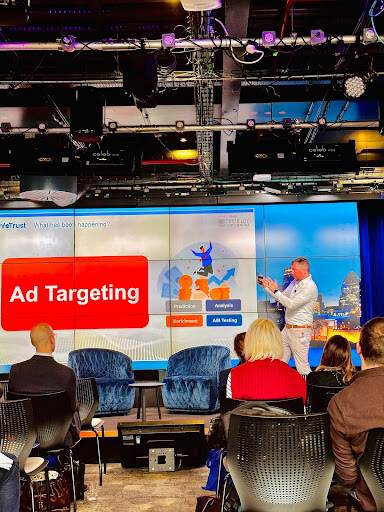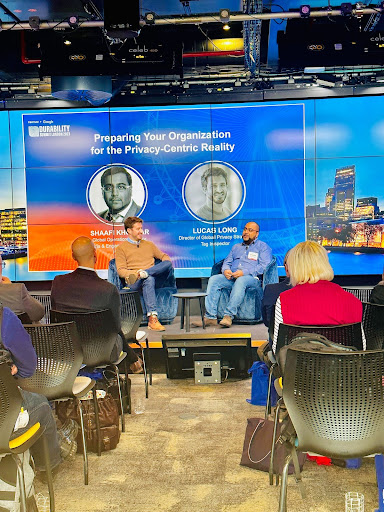Consumers expect a higher-than-ever level of personalization in their interactions with brands. At the same time, the changing privacy environment presents more challenges for marketers and advertisers to be able to effectively deliver personalization. This is true for both on-site experience as well as in the advertising experience. To help marketers with strategies and tactical examples for how to solve this complex puzzle, InfoTrust and Google hosted the first-ever London Durability Summit on March 8, 2023.
The 2023 London Durability Summit included sessions from leading thought leaders and enterprise organizations. Sad you missed out? Have no fear! Let’s go through each session and the key takeaways.
Session 1: The Privacy-Centric World: Challenges & Solutions
Presenter: Adam Taylor, UK Ads Privacy Lead, Google

Adam started the day with a discussion about the importance of placing consumers at the center of your privacy strategy and experience. According to recent research from Google and Ipsos, a positive privacy experience can increase the share of brand preference by 43%. Adam explained the importance of these findings and provided a number of ways to deliver a positive privacy experience, all centered around giving the consumer a feeling of control. Tactics such as asking how and how often consumers want to be reminded of privacy settings, sending privacy digests via email, and asking for meaningful consent for specific actions all contribute to increased feelings of control. All of this leads to higher rates of user engagement and consent, resulting in more first-party data which can be used to deliver the personalized experiences consumers demand.
Too often in today’s environment organizations lose sight of the consumer perspective, instead focusing entirely on tactical solutions to the data challenges being faced. Resetting to a consumer centric perspective can lead to significant competitive advantage.
Respecting the user, earning trust, and building the consumer relationship are important first principles, but once the relationship has been built and data exchanged it’s important to have the platforms and processes in place to derive meaningful insights. One of the most popular platforms used to this end is Google Analytics. Ways to approach the use of Google Analytics 4 (GA4) in a privacy-centric manner were covered in our second session of the day.
Session 2: Privacy Focused Measurement with GA4
Presenter: Nidhal Firoze, Strategist & Team Lead, InfoTrust

Nidhal explained the major structural shift in the data model introduced by GA4, moving to an event and user data model to power additional features and functionality. Emphasized was the importance of doing more with less data. The foundation of this is to start with a meaningful purpose behind all of the data that is collected. Outline the primary use cases of data and follow principles of data minimization to collect in a privacy-focused manner. Beyond the strategic, also discussed were more tactical features and functionalities offered by GA4—Google Signals, Consent Mode, advanced ML/AI—to further help in the goal of doing more with less. Finally, privacy-focused functionality such as data deletion, IP anonymization, and transparency requirements were all covered to help with GA4 compliance.
One of the main concepts woven through Nidhal’s presentation was the need to be very intentful about what data is collected and ensuring it is absolutely necessary to accomplish defined use cases. More broadly in an organization, this theme of intent is very important for privacy-centric marketing. There are no shortage of use cases and challenges to potentially solve—how is a marketer meant to prioritize and select the most appropriate at any given time? In our third session we explored this question and how a test, learn, and scale process can be leveraged for success.
Session 3: Approaching Cookieless Solutions in the Enterprise
Presenters: Jaime Rodera, Data Privacy and Consumer Data Manager, Nestle + Lucas Long, Director of Global Privacy Strategy, Tag Inspector

In this session, Jaime and Lucas discussed ways in which enterprises should approach new cookieless solutions being brought to market using a test, learn, and scale framework. A specific case study example was used looking at Nestle’s testing of Google Consent Mode in GA4. In this case, a test was configured on select websites to assess how Consent Mode could address the specific challenge of a drop in observable user behavior on brand websites. The test analysis proved successful with a demonstrated uplift of approximately 23 percent in observable users and 43 percent uplift in observable total events in GA4.
Beyond this test, Jaime explained the ways in which he is identifying and prioritizing business challenges in the global team and how he works hand-in-hand with legal to find compliant solutions that can work in the business.
The process of identifying business challenges, outlining potential solutions, testing them, and then scaling those that prove successful is critical in the new privacy-centric environment. There are no shortage of proposed solutions available; organizations that effectively identify the best options for their business will be those that thrive. One such solution gaining traction is server-side tag management. This solution was the focus of the fourth session of the day.
Session 4: Taking Control of Your Data with Server-Side GTM
Presenter: Tyler Blatt, Manager of Emerging Solution Strategy, InfoTrust

Tyler started by explaining how we got to where we are today with a proliferation of digital technologies and new ubiquitous user tracking, a place that consumers are not comfortable with. He then went through the various different use cases that can be accomplished with data, the core concept being that we are simply asking different questions of our data. Over time, the questions we ask are largely the same but the mechanisms used to answer the questions are evolving. To illustrate this, Tyler explained the shift from client-side to server-side data distribution and tag management and why server-side is a much better solution for the privacy-centric world. Some of the reasons for this are the ability to enrich, process, and respond to data with a server-side approach, the naturally more private way in which data is processed, and the first-party control offered by a server-side architecture.
It’s clear that the technology is available to allow businesses to answer primary marketing and advertising questions in the new environment—it’s now time for organizations to take action.
It’s at this action stage where enterprises often get stuck—“Ok, I get it—we need to assert more control over our data, we plan to invest in new privacy-centric technologies, we’re trying to derive better insights from our owned data sources to drive our marketing and media strategy. But my teams aren’t getting bigger, my budget isn’t growing significantly, and every conversation I have a different potential solution is presented. How am I supposed to decisively move forward?”
It’s this question we set out to answer with our fifth session of the day, focused on ways to accelerate digital transformation by leaning on partners.
Session 5: Effective Transformation: Working Together to Realize Competitive Advantage
Presenters: Amy Copeland, Director Global Data and Tech EMEA, Google + Michael Loban, Chief Growth Officer, InfoTrust

Amy started the session explaining how digital marketing transformation at enterprises is too often slow and prone to failure, with 65 percent of digital transformations currently not on track to achieve their objectives and 83 percent of digital and analytics transformations failing to ultimately ever achieve their objectives. One of the main reasons for this are integration challenges, with 88 percent of leaders citing this as a factor in slowing transformation. To overcome this challenge, a main area of focus needs to be multi-partner orchestration. Multi-partner orchestration is a marketer’s ability to manage more than one marketing service provider to activate a digital transformation roadmap. Amy then shared seven different commitments a client organization can make to be more effective in managing multiple providers and how those commitments will lead to success.
Following Amy’s overview, Michael then joined for a Q&A to further explore examples of organizations that have done this well, as well as common reasons for failure and how to overcome them.
The discussion of multi-partner orchestration brings us back to the topic of people. How do you work together across people teams in order to realize successful privacy-centric transformation? This is a shift from the past 10-15 years of digital advertising where the focus has really moved to platforms and technology. How best to organize people and processes within the enterprise was the focus of our sixth and final session of the day.
Session 6: Preparing Your Organization for the Privacy-Centric Reality
Presenters: Shaafi Khokhar, Global Operations Director Media & Engagement Platforms, Haleon + Lucas Long, Director of Privacy Strategy, Tag Inspector

In this session, Shaafi and Lucas discussed various foundational initiatives and how Shaafi and the Haleon team successfully completed each in their privacy-centric transformation journey. This started with the implementation and refinement of the consent architecture across all global websites. Insights for how to get global buy-in and how to communicate business impacts to be expected were shared. Other initiatives such as aligning marketing data taxonomies to enable integration and analysis, running test and learn processes, and beginning to implement server-side data distribution were also explained.
A central theme to the discussion was the need for cross-functional alignment and collaboration. Shaafi discussed how they use a formal governance council to evaluate business challenges and proposed solutions from perspectives of all relevant stakeholders and then efficiently execute with assigned ownership.
Execution, the all important concept, is how we ended the day. Throughout the Summit many potential strategies were shared, frameworks and examples for how to test and scale, and recommendations for how to structure teams were outlined. We covered the people, processes, and platforms that can be cornerstones of a successful transformation. Now it is up to you and your organization to execute and become a privacy-centric marketing organization.


